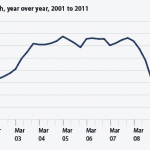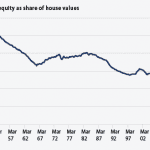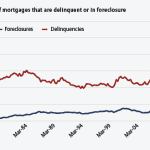This article was created by the Center for American Progress.
Past policies to stabilize the economy and get the labor market moving again are paying off. The unemployment rate is dropping, household debt levels are declining, and household distress is easing.
But these gains are tentative and could quickly evaporate. Job growth is still relatively weak. Debt, credit card defaults, and foreclosures remain relatively high. Oil prices are rapidly rising, putting a damper on household budgets. And the trade deficit stays stubbornly high, which endangers long-term economic growth.
Policymakers need to secure the recovery’s gains while strengthening it. This means maintaining consumption and investment growth in the short term and addressing trade and budget deficits in the medium term. Congress must find a reasonable, growth-enhancing balance between spending cuts and revenue increases in the budget battle.
 1. The U.S. economy continues a moderate recovery. Gross domestic product, or GDP, grew at an annual rate of 2.8 percent in the fourth quarter of 2010, the sixth quarter of positive growth in a row. Consumption grew at an annual rate of 4.1 percent in the same quarter, which is the highest rate since the fourth quarter of 2006. Finally, year-over-year investment growth was 10 percent in the fourth quarter of 2010—the highest such growth since the fourth quarter of 2000.
1. The U.S. economy continues a moderate recovery. Gross domestic product, or GDP, grew at an annual rate of 2.8 percent in the fourth quarter of 2010, the sixth quarter of positive growth in a row. Consumption grew at an annual rate of 4.1 percent in the same quarter, which is the highest rate since the fourth quarter of 2006. Finally, year-over-year investment growth was 10 percent in the fourth quarter of 2010—the highest such growth since the fourth quarter of 2000.
2. The trade deficit stays high. The U.S. trade deficit stood at 3.3 percent of GDP in the fourth quarter of 2010, up from its last trough of 2.4 percent of GDP in the second quarter of 2009. U.S. exports are still expanding at solid rates with 9.6 percent in the fourth quarter of 2010, while imports dropped by 12.4 percent. This is the first decrease in imports since the second quarter of 2009. More than 90 percent of this import decline came from lower petroleum imports.
3. The labor market recovery slowly takes hold in the private sector. The U.S. economy continuously added private-sector jobs from February 2010 to February 2011 for a total of 1.5 million jobs. This included 222,000 new private jobs in February 2011— the fastest monthly growth rate since April 2010.
4. Unemployment stays high because of a massive jobs hole. There were still 7.5 million fewer jobs in January 2011 than at the start of the recession in December 2007. The population has also grown, putting the labor market deeper into the hole than the raw number suggests. The unemployment rate, consequently, remains stubbornly high. It fell below 9 percent in February 2011 to 8.9 percent for the first time since April 2009.
5. Unemployment stays high among the most vulnerable. The African-American unemployment rate stood at 15.3 percent in February 2011, the Hispanic unemployment rate at 11.6 percent, and the white unemployment rate at 8.0 percent. Youth unemployment stood at a high 23.9 percent. And the unemployment rate for people without a high school diploma stayed high at 13.9 percent compared to 9.5 percent for those with a high school diploma and 4.3 percent for those with a college degree.
6. Rapidly rising oil prices threaten a fledgling recovery. A gallon of regular gasoline cost $3.52 in the first week of March 2011, which is 30.4 percent higher than a year earlier. This is the highest gasoline price since the end of September 2008.
7. Employer-provided health insurance benefits continue to disappear. The share of people with employer-provided health insurance dropped from 64.2 percent in 2000 to 55.8 percent in 2009. This is the lowest share since the Census started to track these data in 1987.
8. Family incomes drop sharply in the recession. Median inflation-adjusted household income fell 3.6 percent in 2008 and by another 0.7 percent in 2009. It stood at $49,777 in 2009. This is its lowest level in inflation-adjusted dollars since 1997. White family income stood at $54,461, compared to African-American family income, which was $32,584, or 59.8 percent of white income. Hispanic family income was $38,039 in 2009, or 69.8 percent of white income.
 9. Poverty continues to rise. The poverty rate stood at 14.3 percent in 2009—its highest rate since 1994. The African-American poverty rate was 25.8 percent, the Hispanic rate was 25.3 percent, and the white rate was 9.4 percent in 2009. The poverty rate for children under the age of 18 stood at 20.7 percent. More than one-third of African-American children (35.7 percent) lived in poverty in 2009, compared to 11.9 percent of white children and 33.1 percent of Hispanic children.
9. Poverty continues to rise. The poverty rate stood at 14.3 percent in 2009—its highest rate since 1994. The African-American poverty rate was 25.8 percent, the Hispanic rate was 25.3 percent, and the white rate was 9.4 percent in 2009. The poverty rate for children under the age of 18 stood at 20.7 percent. More than one-third of African-American children (35.7 percent) lived in poverty in 2009, compared to 11.9 percent of white children and 33.1 percent of Hispanic children.
10. Family wealth losses linger. Total family wealth was down $12.8 trillion (in 2010 dollars) from June 2007—its last peak—to December 2010. This is despite an increase of $6.6 trillion in 2010 dollars from March 2009—the lowest point during the recession— to December 2010. Home equity is also recovering but homeowners on average still own only 38.5 percent of their homes. Mortgage banks own the rest.
 11. Debt levels are still high. Total household debt equaled 116.1 percent of after-tax income in December 2010. This is down from a record high of 130.2 percent in September 2007. But it is still higher than at any point before 2005.
11. Debt levels are still high. Total household debt equaled 116.1 percent of after-tax income in December 2010. This is down from a record high of 130.2 percent in September 2007. But it is still higher than at any point before 2005.
12. Mortgage troubles stay high. One in eight mortgages is delinquent or in foreclosure. The share of delinquent mortgages was 8.2 percent in the fourth quarter of 2010 and the share of mortgages that were in foreclosure was 4.6 percent. The latter is the highest share on the Mortgage Bankers Association’s records that date back to 1979.
13. Families feel the pressure. Credit card defaults amounted to a high 7.7 percent of all credit card debt in the fourth quarter of 2010. This rate is down 29.4 percent from its peak in the second quarter of 2010. But it is still 85.5 percent above the rate in the fourth quarter of 2007 right before the Great Recession started.


